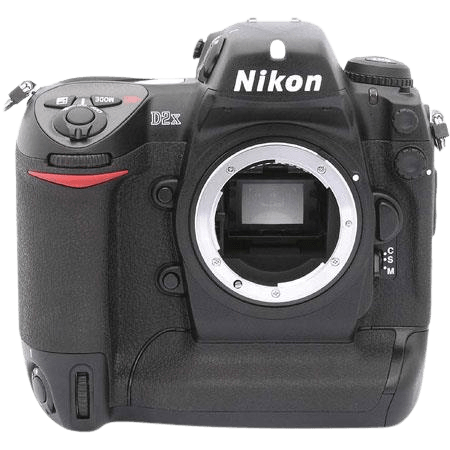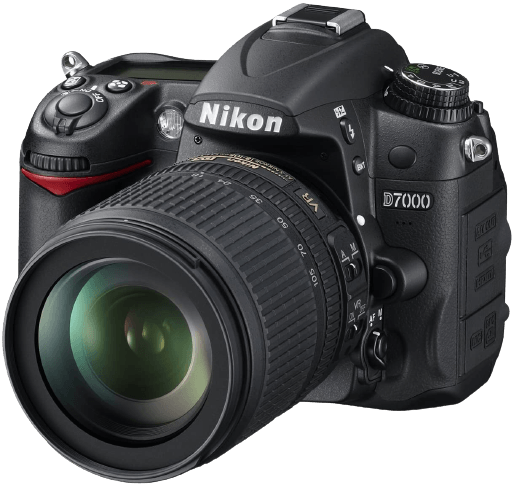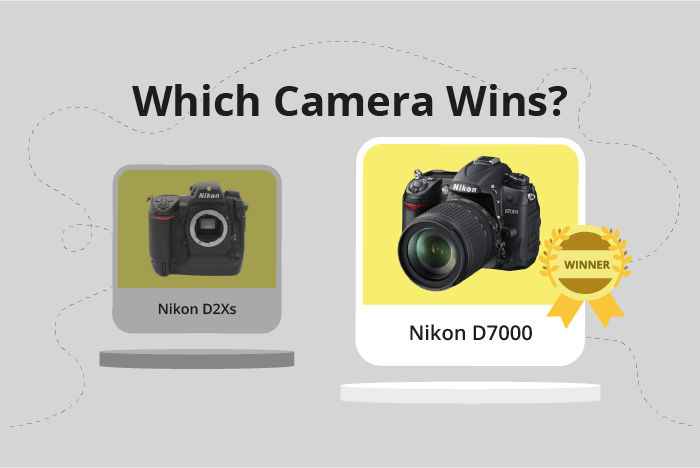Nikon D2Xs vs D7000 Comparison
Nikon D2Xs

Nikon D7000

The Nikon D7000 outperforms the Nikon D2Xs with a score of 54/100 compared to 36/100. Both cameras share common specifications as they are both DSLR cameras, announced in 2010 and 2006, respectively. The D7000 is a more affordable option with a launch price of $1200, while the D2Xs was priced at $4250.
The D7000 is superior due to its compact size (132 x 105 x 77mm) and lighter weight (780g), making it more convenient for photographers. On the other hand, the D2Xs has a larger size (158 x 150 x 86mm) and heavier weight (1200g), potentially offering better stability while shooting.
Despite the lower score, the D2Xs may still appeal to some users due to its sturdier build and professional-grade features. However, the D7000’s higher score, affordability, and portability make it the better choice for most photographers.
Nikon D2Xs vs D7000 Overview and Optics
The Nikon D7000 wins in the optics comparison with a score of 55/100, while the Nikon D2Xs scores 43/100. Both cameras share some common specifications, including the CMOS sensor type, APS-C sensor size, Nikon F lens mount, and the absence of image stabilization.
The Nikon D7000 excels due to its higher megapixels, 16.2 compared to the D2Xs’ 12.2. This allows for more detailed images and better cropping flexibility. Additionally, the D7000’s Expeed 2 processor contributes to improved image quality and performance. The most significant advantage of the D7000 is its DXOMARK sensor score of 80, which indicates better overall image quality, dynamic range, and low light performance than the D2Xs, which only scores 59.
On the other hand, the Nikon D2Xs has a faster shooting speed of 8 frames per second compared to the D7000’s 6 frames per second. This makes the D2Xs better suited for capturing fast-moving subjects and sports photography.
Taking these factors into consideration, the Nikon D7000 is the superior choice in terms of optics, thanks to its higher megapixel count, better image processing, and improved sensor performance. However, the Nikon D2Xs still has its merits, particularly when it comes to capturing fast-moving action with its higher shooting speed. Ultimately, the choice between the two cameras depends on the specific needs and priorities of the photographer.
Nikon D2Xs vs D7000 Video Performance
When comparing the Nikon D2Xs and the Nikon D7000, it is essential to note that the D2Xs does not have any video functionality. This lack of video capabilities is a significant difference between the two cameras. Therefore, the focus of this comparison will be on the video features of the Nikon D7000.
The Nikon D7000 has a video score of 57 out of 100, which shows that it offers reasonable video capabilities. The camera can record videos at a full HD resolution, with maximum dimensions of 1920 x 1080 pixels. This resolution ensures that users can capture high-quality videos with clear details. Moreover, the D7000 can record video at a maximum frame rate of 24 frames per second, which provides smooth and natural motion in the recorded footage. Additionally, the camera has a built-in time-lapse functionality, allowing users to create stunning time-lapse videos without requiring additional software or equipment.
Taking these video capabilities into account, it is clear that the Nikon D7000 offers a more comprehensive and versatile photography experience compared to the Nikon D2Xs, which lacks video functionality. Users who prioritize video recording should consider the D7000 as a more suitable option for their needs.
Nikon D2Xs vs D7000 Features and Benefits
The Nikon D7000 comes out ahead of the Nikon D2Xs in features with a score of 54/100, compared to the D2Xs’ 17/100. Both cameras share certain specifications, but the D7000 has a clear advantage in several aspects.
Both cameras have a non-touchscreen, non-flip screen. Neither of them has GPS or Bluetooth capabilities. However, the similarities end there. The D7000 boasts a larger screen size of 3 inches, compared to the D2Xs’ 2.5 inches. Furthermore, the D7000 has a significantly higher screen resolution of 921,000 dots, while the D2Xs has only 235,000 dots. This difference results in a clearer and more detailed display on the D7000.
The Nikon D7000 also has built-in WIFI, which the D2Xs lacks. This feature allows the D7000 to transfer photos and videos wirelessly to compatible devices, making it more convenient for sharing and backing up media.
The Nikon D2Xs does not have any notable advantages over the D7000 in terms of features. The lower score reflects its limited capabilities compared to the more advanced D7000.
Considering the differences in features, the Nikon D7000 is the superior camera. Its larger and higher-resolution screen, along with WIFI connectivity, provide users with a more convenient and enjoyable photography experience. On the other hand, the Nikon D2Xs falls short in these areas, making it a less attractive option for photographers seeking advanced features.
Nikon D2Xs vs D7000 Storage and Battery
The Nikon D2Xs outperforms the Nikon D7000 in storage and battery with a score of 51/100 compared to 45/100. Both cameras have one memory card slot; however, the D2Xs accepts Compact Flash (Type I or II), while the D7000 uses SD, SDHC, and SDXC cards. Neither camera offers USB charging.
The D2Xs excels with its battery life, providing 2000 shots per charge using the EN-EL4a battery, almost double the D7000’s 1050 shots with its EN-EL15 battery. This makes the D2Xs ideal for extended shooting sessions without needing frequent battery replacements.
The D7000 has the advantage of using more commonly available SD-type memory cards, which are often easier to find and more affordable than Compact Flash cards. However, this benefit is not enough to surpass the D2Xs in overall storage and battery performance.
In comparing storage and battery capabilities, the Nikon D2Xs emerges as the superior option due to its longer battery life. The Nikon D7000’s use of SD-type memory cards is a minor advantage but does not outweigh the D2Xs’s strengths.
Nikon D2Xs vs D7000 – Our Verdict
Are you still undecided about which camera is right for you? Have a look at these popular comparisons that feature the Nikon D2Xs or the Nikon D7000:

